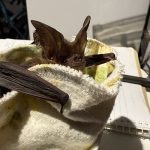LESSER LONG-EARED BAT
The Lesser Long-eared Bat
The Lesser long-eared bat (Nyctophilus geoffroyi) is a small, secretive and highly adaptable microbat found across much of Australia. Though often overlooked because of its nocturnal and inconspicuous nature, it plays a vital role in maintaining ecosystem health through its insect-eating habits.
Appearance and Identification
This bat is named for its remarkably long ears, which are almost as long as its head and body combined. These ears are not just for show — they are finely tuned instruments for detecting the faintest rustle of insect wings or movement in leaf litter.
Key features:
- Size: 6–10 grams in weight; forearm length around 30–38 mm.
- Fur: Soft, usually light brown to grey-brown on the back, with paler underparts.
- Ears: Long and flexible, joined across the head by a thin membrane.
- Face: Short muzzle, with a well-developed tragus (the upright flap inside the ear).
Distribution and Habitat
The Lesser long-eared bat is one of Australia’s most widespread bat species. It can be found in:
- Woodlands
- Open forests
- Shrublands
- Semi-arid and arid zones
- Urban parks and gardens (especially where old trees or roosting sites are available)
It ranges across most of mainland Australia, from coastal forests to inland deserts, avoiding only the most treeless plains and wettest rainforests.
Behaviour and Ecology
Nocturnal Lifestyle
This bat emerges at dusk, flying low and weaving between trees and shrubs. It is a slow and highly manoeuvrable flier, well adapted for hunting in cluttered environments.
Diet
The Lesser long-eared bat feeds mainly on:
- Moths
- Beetles
- Flies
- Other small flying insects
It uses echolocation — high-frequency calls inaudible to humans — to navigate and locate prey, but also listens for the rustle of insects on leaves, demonstrating passive listening.
Roosting
During the day, it roosts in:
- Tree hollows
- Loose bark
- Foliage
- Occasionally in buildings or sheds
Roosts are usually shared by small groups, although solitary roosting also occurs.
Breeding
- Mating: Likely occurs in autumn.
- Births: Usually in late spring to early summer.
- Litter size: Typically twins — a relatively high number for a bat of its size.
- Young are born furless and completely dependent, clinging to their mother’s fur until they are old enough to be left in the roost.
Role in the Ecosystem
The Lesser long-eared bat is an important natural pest controller, consuming large numbers of insects each night. This benefits both natural habitats and agriculture by reducing pest populations without the need for pesticides.
Conservation Status
This species is listed as Least Concern nationally, thanks to its wide distribution and adaptability. However, it still faces threats such as:
- Loss of roosting trees through land clearing
- Use of pesticides reducing insect prey
- Predation by cats
- Disturbance to roost sites
Conservation tip: Protecting old, hollow-bearing trees and maintaining insect-rich environments is crucial for their survival.
Meeting the Lesser long-eared bat
Imagine standing in the stillness of an Australian woodland on a warm summer night. The air is alive with the soft hum of crickets. A faint flutter passes above, so quick you almost miss it. In the moonlight, a small silhouette darts between branches — its long ears catching the light for a heartbeat before it vanishes into shadow. You hear nothing, yet the bat is navigating a world of sound beyond human hearing, weaving through the night in search of the tiny winged creatures that form its feast.

